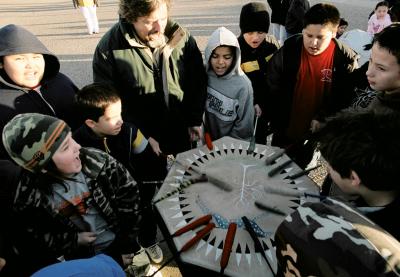Vicki Sherman starts her day with a cup of Folgers and a glance at her to-do list, even though halfway through the morning, the list will fly out the window.
The phone keeps ringing. Three students wait their turn outside her door. And she's running late for a meeting.
"It's always something," says Sherman, the principal at Todd County High School.
In many ways, Sherman's school could be anywhere. The successes and challenges here are similar to those at schools across the country: The debate team just won a state medal; mandated content standards don't always match what students need to learn.
The difference, Sherman says, is that Todd County High sits on the middle of an Indian reservation, tucked in the hills of rural South Dakota.
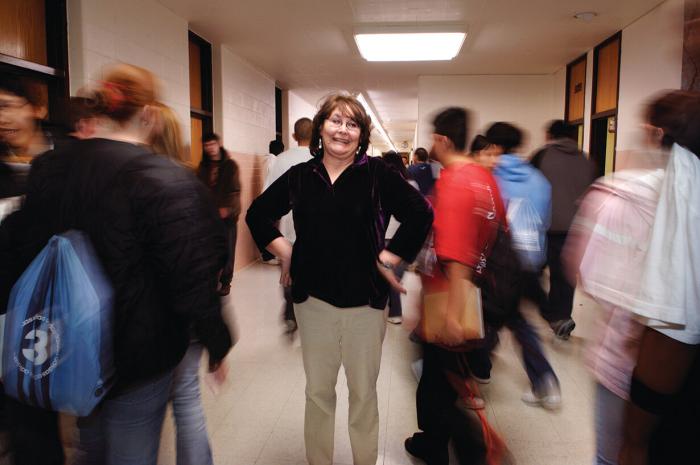
'We need to bring them back'
Todd County, S.D., is synonymous with the Lakota Rosebud Reservation. It stretches across the state's south-central edge, bordered on one side by the better known Pine Ridge Reservation, where the American Indian Movement got its start, and on another side by Nebraska.
Todd County is the fifth poorest county in the nation. According to the U.S. Census, the per capita income for Native residents, who comprise about 87 percent of the population, is $5,875. For white residents, it's $17,932.
Todd County High, one of two high schools on the reservation, draws about 480 students from 22 communities. It's located in Mission, S.D., a town of almost 900 people that once prospered, locals say, with a movie theater and restaurants, hotels and appliance stores. Now, it's a row of mostly boarded-up storefronts, a town where the gas station doubles as the local coffee shop, and pickup trucks rumble past the ramshackle drive-through burger place.
Darrin Big Crow, a senior at Todd County High, sounds a lot like any teenager in rural America. "There's not a lot for kids to do around here," he says. "I'm always trying to find something to do to keep myself out of trouble."
For many teens, drugs and gang activity fill the void. Last year, threats from rival gangs prompted a lockdown at Todd County High. At the time, the school reported at least 77 active gangs on the reservation.
Other challenges here mirror those too common in Indian Country: 58 percent of the students qualify for ESL classes, even though English is their first language; teen pregnancy and dropout rates surpass national averages.
"These behaviors are taking our kids farther away from who they are," says Denise One Star, Lakota studies coordinator for the Todd County School District. "We need to bring them back."
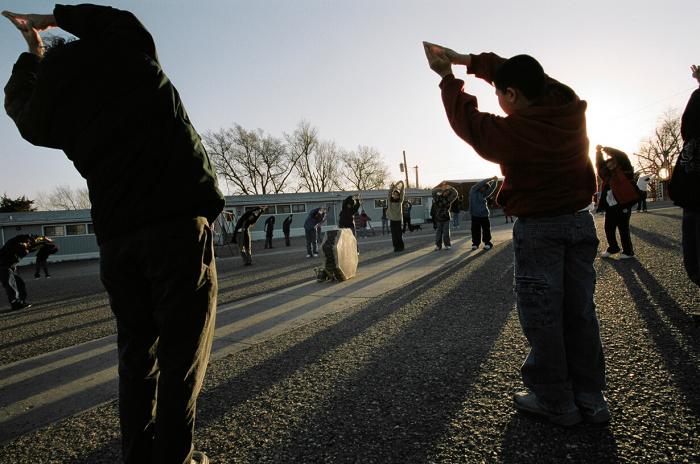
'Genocide of a culture'
Until the 1970s, generations of Indian children were forced from their homes and placed in schools run by the U.S. government and later by Christian missionaries, where they were beaten for speaking their language, their traditional clothes and hair were stripped from them, and they sometimes were given new Judeo-Christian names.
"It was complete genocide of a culture," says Dwayne Hollow Horn Bear, a Lakota Studies professor at Mission's Sinte Gleska University, one of about 35 Native colleges and universities in the country. "They would carry a Bible in one hand and talk about God. Then they would carry a stick in the other hand and beat them with it."
The schools were designed to systematically destroy the passage of cultural identity from one generation to the next. The goal was clear, as Richard C. Pratt, who founded the first boarding school in Pennsylvania, infamously stated in 1892: "Kill the Indian, and save the man."
"My father was whipped every time he spoke Lakota in school, so he never taught us the language. It was painful for him, and he didn't want that pain passed on to his children," says Bob Boyd, who was born and raised in Mission and now teaches history at Todd County High. "I learn everything I can about my culture; and what I learn, I pass on to my students. Because the same thing has happened to a lot of their families, too."
Another teacher said virtually all of her students had at least one grandparent who had gone through the boarding school system.
Educators here see the connection between this cultural loss and the poverty and substance abuse issues affecting their students' lives. And they argue that for many students, an improved sense of what it means to be Lakota is the jump-start they need to steer clear of drugs and alcohol and stay on track in school.
"We have kids who identify more with the gang culture they see on TV than with their own culture," says Sherman.
Adds senior Marjorie "Jorie" Lunderman, who plans to enroll at Sinte Gleska next year: "If you don't know your history, it's hard to be proud of where you come from."
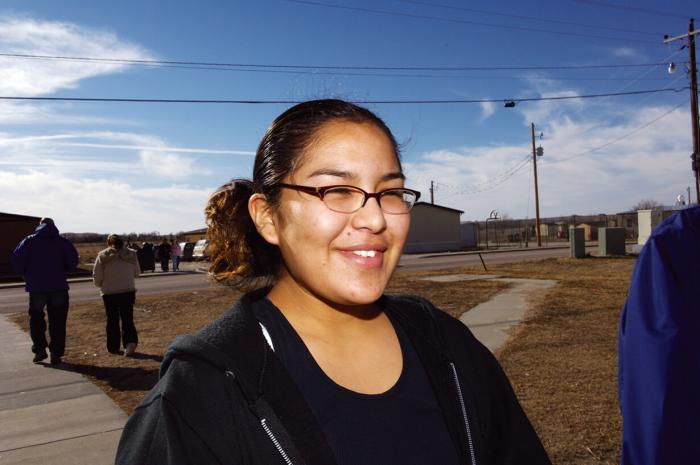
A cultural disconnect
Sometimes, the people in charge of what students learn can be part of the problem.
Sherman says many of the challenges at Todd County High are exacerbated by a disconnect between her mostly Native students and her mostly white, middle-class teachers.
Almost all of her students live on the reservation, while many teachers commute from border towns just outside the reservation's boundaries. Most students are enrolled tribal members, yet most teachers don't speak Lakota or understand Lakota customs.
Sherman is only the second Native administrator in the school's history. A former principal, a white man, once rejected a teacher's request to start a Lakota literature class. Sherman winces when she recalls what he said: "We don't need that here."
"We deny these are Indian kids." she says. "We have teachers that don't connect with the students or where they come from. I think it's extremely vital that if we want our kids to learn, that connection needs to happen."
The Todd County School District increasingly promotes culturally responsive curriculum to make that connection stick.
Culturally responsive curriculum represents a radical departure from the usual approach to multicultural education. Instead of tacking cultural information onto existing curriculum, it calls for embedding it into everyday lessons, building on students' experiences and making lessons relevant to what students already know.
Making the case for it has not been easy in Todd County.
Last fall, Sherman started the school year with a training for her staff. She showed them the research: When teachers demonstrate knowledge and respect for their students' cultures — and when traditions and experiences rooted in those cultures are infused into the curriculum in meaningful ways — student achievement skyrockets, according to studies from the Northwest Regional Education Laboratory, Western Washington University and elsewhere.
But some Todd County teachers worried that addressing Lakota studies in the classroom would detract from the basics that some students desperately need.
"What I got from that meeting was a bunch of defensive teachers," Sherman says. "I showed them the data that backs this up, but a lot of them didn't want to believe it."
Making connections
To Frank Baca, an American literature teacher at Todd County High, culturally responsive curriculum means starting the semester with books written by Native authors, before moving on to Hemingway and Twain.
"I teach all of that, too," Baca says, "but I start with Native literature to connect it to their lives."
This is one of the tenets of culturally responsive education: that teachers should build meaningful bridges between what students experience at home and what they're taught in school.
Another tenet is the recognition of multiple truths — that there's more to history than what's in the textbooks, which traditionally have been written from white, English-speaking perspectives.
"With textbook learning, you have to have a teacher who knows our history, so that they can add to the book and even correct it," says senior Francis Krug, whose mom is a history professor at Sinte Gleska. "Sometimes she'll look at my book when I'm doing homework and go, 'That's wrong, and that's wrong.'"
According to Geneva Gay, author of "Culturally Responsive Teaching: Theory Research and Practice," weaving information about a variety of cultures into the curriculum improves students' interpersonal skills and deepens their intellectual curiosity.
Brent Larvie, a junior, wishes more classrooms across the country approached history and culture this way. "Other kids learn stereotypes about us from the movies," he says. "It's important to teach about Indian cultures so that we're not portrayed as savages and alcoholics."
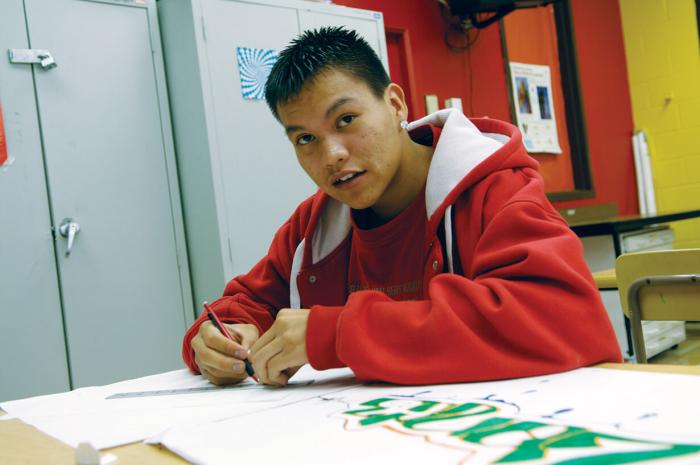
Teachers who believe
Billie Jean Felix and her four younger siblings are among the 120 or so Todd County students who live in dormitories on the school's sprawling campus. The Felix kids grew up in Winner, S.D., a border town just east of the reservation with a reputation for being an unwelcoming place for Indians.
Unlike the boarding schools of the past, these dormitories are for students whose families live too far away to drive them to school every day, or who live in towns like Winner, where the school district is under investigation for discriminatory treatment of Native students.
For the Felix siblings, it's a little more complicated. For eight months last year, the Felix family was homeless. The dormitory guaranteed a place to stay and meals to eat five days a week. On the weekends, when the dorm was closed, the kids slept with relatives and friends, or sometimes in the family van.
As a result, Billie struggled with depression and got into fights with other girls. Joining the school's hand-stick team, a traditional Lakota sport, and participating in sweat lodges and sun dances is helping her change course.
"The Lakota ways are slowly fading, because the generation that knows them are dying," she says. "When I try to talk to other kids about our history, they're not really interested. They don't think it affects them."
Last fall, Billie attended a conference in Denver sponsored by the National Indian Education Association. Students from Native American tribes across the United States were there, sharing experiences and stories and discussing strategies for improving their campuses.
"To hear other people talk about their experiences makes you want to learn more about your own culture and tell your story," she says.
But when she returned to campus, there were few outlets for the kind of cultural sharing that had occurred in Denver.
"We need more teachers who think we Native kids can succeed," Billie says. "A bunch of teachers here, they think they know what's wrong with us. But they don't know. If people want to help us, they have to see what we've been through, not from what their own experiences tell them."
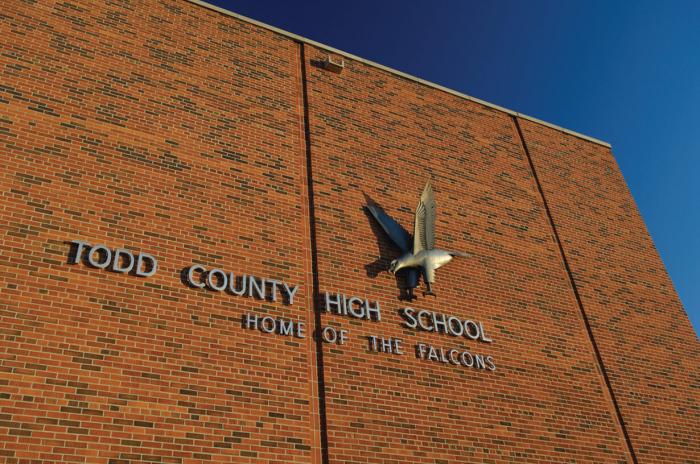
Grieving history
Every semester in his Lakota Studies class, says professor Hollow Horn Bear, some of his students will ask, "Why weren't we told these things?"
"They respond with a lot of anger," he says. "To deal with that, I encourage them to go through a grieving cycle."
On a windy day in January, his students pile into a van and drive a few miles outside of town, to a rolling expanse of grassland owned by the university. A herd of buffalo roams below, dark specks against the wheat-colored prairie.
The students are here to witness a ceremonial buffalo kill; the tribe's Founders' Day Celebration is next week, and they need buffalo meat to feed the expected crowd.
"This is the way our ancestors lived," Hollow Horn Bear tells the group, "yet most of you have probably never witnessed this."
The ceremony begins. Someone kneels down to light a bundle of sage; smoke rises and drifts toward the herd, as Hollow Horn Bear lifts a hide-covered drum and begins a solitary beat.
The group moves closer to the buffalo. Two men with rifles take aim. When the first shot rings across the field, Hollow Horn Bear and the other bystanders can almost feel the vibration.
Then something surprising happens: When the buffalo falls, the rest of the herd doesn't run. Instead, they circle the fallen animal and let out low, plaintive cries. With their noses, they try to lift him. When it's clear he isn't going to stand, they slowly walk away.
"Watch what the buffalo do when one of their own is wounded," Hollow Horn Bear says. "Watch how they grieve and then move on."
It's a lesson he wants his students to learn.
No more shame
This semester, Vicki Sherman hopes to make strides with her staff. "I ask them to include with their lesson plans how they plan to incorporate Lakota language and culture," she says. "The problem is most of them don't really know how. We just have to keep showing them that it's possible."
Until then, smaller gains will have to do.
Before she leaves for the day, Sherman gives a visitor a tour of the building. "Look around!" she says, pointing to the institutional, pink-and-white tiled walls. "Do you see anything that tells you this school is in the middle of an Indian reservation? My goal is to change that."
A recent art contest was a start. From dozens of submissions, the artwork of a handful of students was chosen to decorate the entryway: a vibrant, multi-colored star quilt; a drawing of the sacred medicine wheel.
"My parents never felt comfortable going into my school," Sherman says. "Those were the years when they made you feel ashamed of who you were. I want to make sure no one feels that way today."
